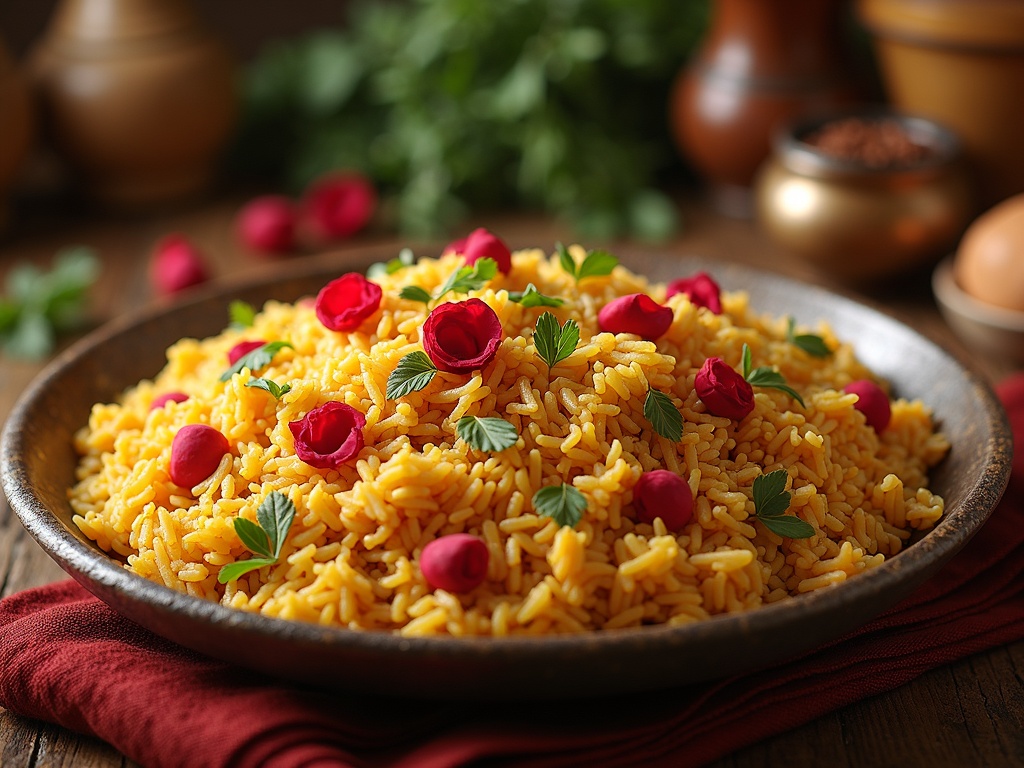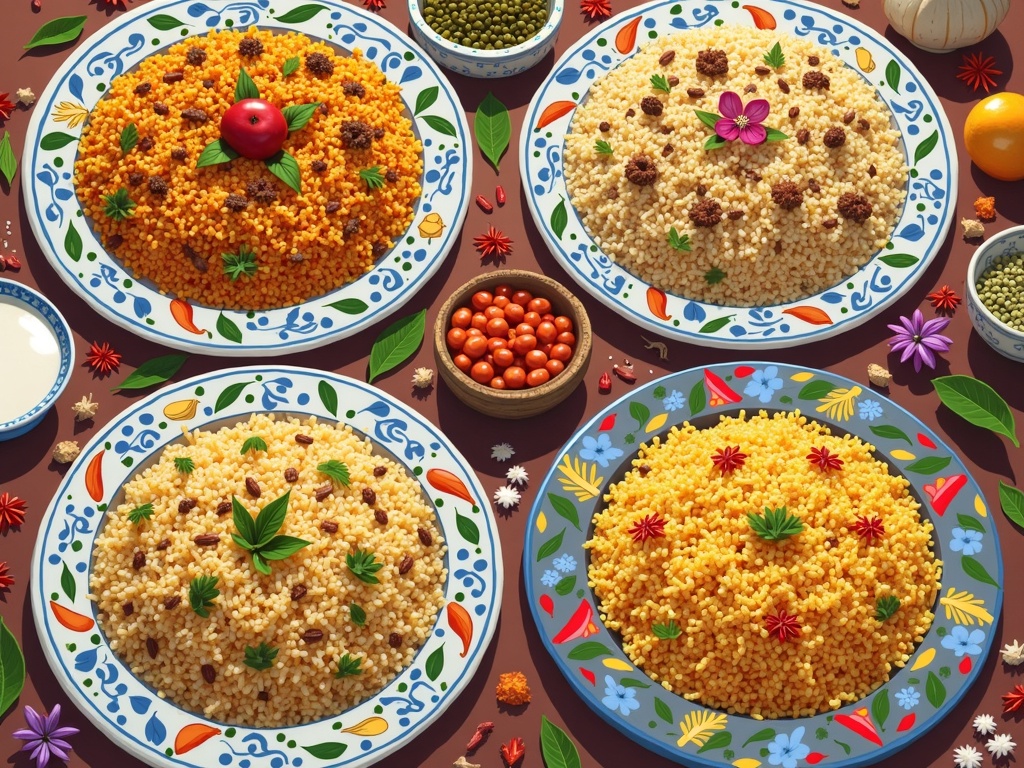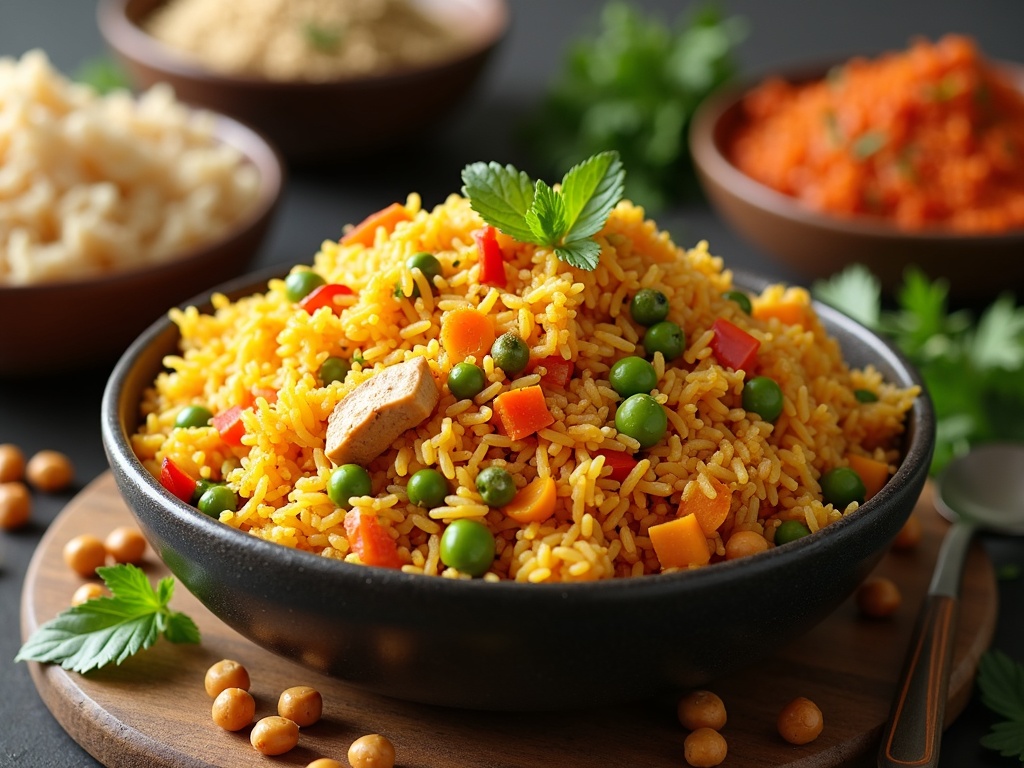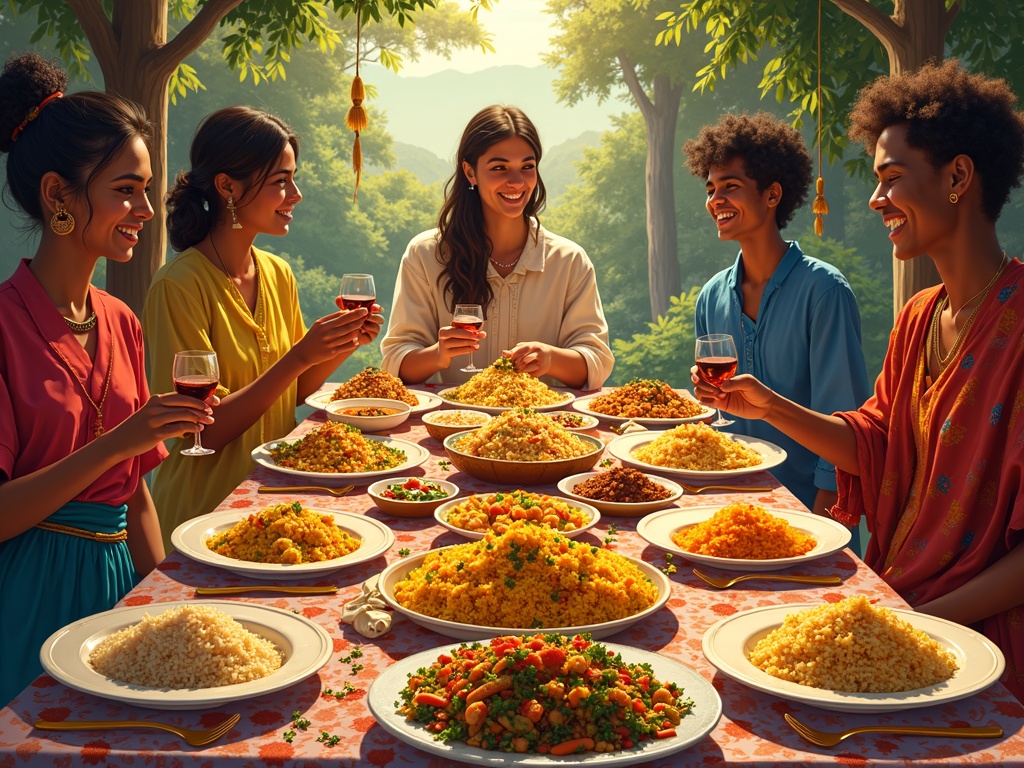Pilau, a flavorful rice dish with ancient origins, has evolved across continents while maintaining its essence as an aromatic, spice-infused preparation. This culinary masterpiece has transformed through centuries of cultural exchange, with each region from the Middle East to South Asia, Africa, and the Caribbean adding unique ingredients and techniques that reflect local tastes and available resources.
Find In This Article
Key Takeaways
- Pilau originated in ancient Persia and spread through trade routes, evolving into regional variations like Indian pulao, Middle Eastern pilaf, and East African coastal versions.
- The perfect pilau technique involves partially cooking rice in fat before adding liquid, using a 1:1.5 rice-to-liquid ratio, and allowing the dish to rest after cooking.
- Regional variations include Indian pulao with complex spice blends, Middle Eastern versions with nuts and dried fruits, East African adaptations with coconut milk, and Caribbean interpretations.
- The dish offers a balanced nutritional profile with approximately 250 calories per cup and can be enhanced with vegetables, lean proteins, or alternative grains.
- Foundation ingredients include basmati rice, aromatic spices (varying by region), ghee or oil, and proteins like lamb, chicken, or vegetables depending on cultural preferences.
A Rich History: From Ancient Origins to Global Fame
The story of pilau rice begins thousands of years ago, weaving through the fabric of Middle Eastern and South Asian culinary traditions. I’ve found that this aromatic rice dish has traveled across continents, evolving with each culture it touched while maintaining its core identity as a flavorful, spiced rice preparation.
Ancient Beginnings and Cultural Evolution
Archaeological findings suggest that pilau’s earliest versions appeared in the fertile regions between the Tigris and Euphrates rivers. Early cooking methods involved layering rice with spices, meats, and vegetables—a technique that forms the foundation of modern pulao recipes today. According to ‘The Oxford Companion to Food’, the earliest documented references to pilau-like dishes date back to ancient Persian texts, where elaborate rice preparations were described for royal feasts.
As trade routes expanded, this cooking method spread throughout the Middle East and into South Asia. The Persian influence on Indian cuisine brought pilau techniques that were adapted to local ingredients and preferences. In India, the dish transformed into what many now recognize as pulao, incorporating regional spices like cardamom, cinnamon, and cloves.
The dish didn’t stop there—it continued its journey westward through the Ottoman Empire and into Eastern Europe, southward into various African culinary traditions, and even eastward into Central Asian cooking styles. Each region contributed unique elements:
- Persian traditions emphasized saffron and dried fruits
- Indian variations incorporated a wide range of spices and often vegetarian ingredients
- East African coastal communities added coconut milk and seafood
- Central Asian versions featured carrots, raisins, and lamb
Celebration and Significance
Throughout its history, pilau has transcended being merely a dish to become a cultural institution. In many societies, veg pulao and meat variations alike are prepared for significant celebrations and gatherings. Wedding feasts across South Asia often feature elaborate pilau preparations, sometimes adorned with silver leaf and rose petals for special occasions.
The communal nature of pilau preparation and consumption speaks to its significance as a dish that brings people together. Large cooking vessels traditionally allowed families to prepare enough food for extended gatherings, making it central to hospitality customs in many cultures.
‘The Oxford Companion to Food’ notes that in several Middle Eastern and Central Asian traditions, the ability to prepare a proper pilau was considered an essential skill for marriage. The dish required precision in technique—achieving perfectly separated grains of rice while infusing them with flavor demanded both knowledge and experience.
What makes pilau particularly special is how it adapts while remaining recognizable. Whether it’s the Uzbek plov cooked in massive cauldrons, the fragrant Indian pulaos served at weddings, or the spiced East African versions, the fundamental technique of cooking rice with spices in a broth connects these diverse interpretations across time and geography.
This culinary journey across continents shows how food transcends borders, adapting to local tastes while maintaining connections to its origins. Few dishes can claim the global impact and cultural significance of pilau, a testament to both its adaptability and its fundamental appeal to human tastes across vastly different cultures and time periods.

The Art of Making Perfect Pilau
Creating the perfect pilau rice is both a science and an art form. I’ve found that mastering a few key techniques transforms this humble dish into something truly special. The secret lies in the preparation method, where rice is partially cooked in fat before adding liquid – a technique that builds incredible depth of flavor.
Essential Techniques for Perfect Results
Rice selection forms the foundation of excellent pilau. Basmati stands out as the ideal choice due to its long grains that cook up fluffy and separate beautifully. The distinctive aroma and ability to absorb flavors make it perfect for this dish. Before cooking, I always rinse the rice thoroughly until the water runs clear to remove excess starch.
The cooking vessel matters significantly. A heavy-bottomed pot distributes heat evenly and prevents hot spots that could lead to uneven cooking or burning. This is particularly important when making pulao or pilau where consistent cooking is crucial.
The partial cooking technique is what sets pulao recipe apart from regular rice. I start by sautéing the rice in ghee or oil until it becomes translucent. This crucial step coats each grain with fat, helping them remain separate when cooked and developing a nutty flavor profile.
For perfect texture, the water-to-rice ratio is critical. I use a 1:1.5 ratio (one part rice to one and a half parts liquid) when using the absorption method. This proportion ensures the rice cooks thoroughly without becoming mushy.
Spice timing and layering create the complex flavor profile that makes veg pulao so delicious:
- Whole spices (cinnamon, cardamom, cloves) go in first with the hot oil to release their essential oils
- Aromatic vegetables like onions follow to build the flavor base
- Ground spices are added later to prevent burning
- Fresh herbs are reserved until the end to preserve their bright flavors
The final crucial step is the resting period. After cooking, I remove the pot from heat and let it sit covered for 10-15 minutes. This allows moisture to distribute evenly throughout the rice, resulting in perfectly tender grains.
By following these techniques, you’ll create pilau with distinct, separate grains, beautifully infused with spices and aromatics – the hallmark of this beloved dish.
Global Flavors: Regional Variations That Define Pilau
Pilau has taken on unique characteristics across different regions of the world, with each culture adding its own special touch to this classic rice dish. I’ve found that understanding these regional variations helps me appreciate the versatility and global appeal of pilau. The beauty of this dish lies in how it has been adapted to suit local tastes while maintaining its essence as a flavorful rice preparation.
Indian Pulao: A Symphony of Aromatic Spices
In India, pulao recipe traditions incorporate a complex blend of aromatic spices that create distinctive flavor profiles. The Indian version typically features basmati rice cooked with whole spices like:
- Cardamom pods that release a sweet, intense aroma
- Cloves that add warmth and depth
- Cinnamon sticks for a subtle sweetness
- Cumin seeds for earthy notes
- Bay leaves for a mild herbal flavor
These spices are often bloomed in ghee before adding rice, creating a fragrant base. Indian pulao can be vegetarian with seasonal vegetables or include meat like chicken or mutton. The dish holds special significance during celebrations and festivals, where it’s often prepared as part of elaborate feasts to honor guests.
Middle Eastern and Central Asian Influences
Moving westward, Middle Eastern pilau showcases a different but equally delicious approach. Here, the dish often features:
- Tender lamb as the protein of choice, slowly cooked to perfection
- A generous handful of nuts like pistachios, almonds, and pine nuts
- Sweet contrasts from dried fruits such as apricots, raisins, and dates
- Saffron threads that impart a golden hue and distinct flavor
In countries like Iran, Turkey, and Uzbekistan, pilaf (as it’s often called) serves as a centerpiece for special occasions and family gatherings. The combination of meat, fruits, and nuts reflects the region’s historical position along ancient trade routes where these ingredients were valued commodities.
East African Coastal Variations
East African pilau, particularly popular in countries like Kenya and Tanzania, bears the marks of centuries of trade with the Arab world and India. The coastal regions have developed a distinctive style characterized by:
- Strong cinnamon and cardamom influences
- Black pepper for heat
- The addition of beef or goat meat
- Coconut milk in some coastal variations
This pilau rice version often accompanies celebrations and important life events like weddings or religious holidays. The dish represents a fusion of African ingredients with spice traditions brought by traders across the Indian Ocean, resulting in a unique culinary heritage that continues to evolve.
Caribbean Interpretations
In the Caribbean, particularly in countries with significant Indian influence like Trinidad and Guyana, pilau has taken on yet another character. The Caribbean version typically includes:
- Local spices that reflect the region’s vibrant food culture
- Coconut milk that adds creaminess and tropical flavor
- Proteins like chicken or salted fish
- Pigeon peas or black-eyed peas for additional texture
This adaptation represents the cultural blending that occurred through migration and colonization. Caribbean veg pulao variations often appear at family gatherings and community events, serving as a reminder of cultural connections that span oceans.
The global journey of pilau demonstrates how food evolves as it travels between cultures. Each regional adaptation tells a story of cultural exchange, available ingredients, and local tastes. What makes pilau special is how it maintains its identity as a celebratory rice dish while embracing new flavors and techniques with each border it crosses.

Nutritional Benefits and Modern Adaptations
Pilau rice offers a balanced nutritional profile that makes it a versatile addition to many meals. A standard cup serving (approximately 200g) contains around 250 calories, making it a reasonable option for those monitoring their energy intake. The macronutrient breakdown includes about 4g of protein, 54g of carbohydrates, and only 0.5g of fat, positioning it as a lower-fat option compared to many other rice preparations.
Nutritional Comparisons and Enhancements
When comparing pilau to other rice dishes, it stands out for its favorable nutritional balance. Unlike fried rice varieties that can contain upwards of 10g of fat per serving, pilau rice keeps the fat content minimal while delivering complex carbohydrates for sustained energy. The aromatic spices used in pilau also contribute antioxidants without adding calories.
I’ve found that pilau becomes even more nutritious when prepared with lean proteins. Adding chicken breast can boost the protein content to about 15g per serving, creating a more complete meal. Fish options like tuna or salmon can introduce beneficial omega-3 fatty acids while maintaining the dish’s integrity.
The vegetable enhancement possibilities are particularly exciting for health-conscious cooks. I recommend these nutrient-boosting additions to traditional pulao:
- Peas and carrots, which add fiber, vitamin A, and natural sweetness
- Bell peppers for vitamin C and vibrant color
- Spinach or kale for iron and calcium
- Chickpeas for additional protein and fiber
- Fresh herbs like cilantro or mint for brightness and antioxidants
For those following plant-based diets, veg pulao provides an excellent foundation. By incorporating tofu or legumes, you can create a complete protein source while maintaining the dish’s traditional flavor profile.
Modern adaptations of pulao recipes have also seen the introduction of alternative grains like brown rice or quinoa, which can increase the fiber content from about 1g to 4g per serving. These substitutions maintain the dish’s essence while catering to contemporary nutritional priorities.
The beauty of pilau lies in its adaptability – you can adjust the ingredients to suit specific dietary needs without sacrificing the characteristic aromatic qualities that make this dish so beloved across cultures.

Essential Ingredients and Spice Combinations
The magic of a flavorful pilau rice lies in its perfect balance of spices and ingredients. The dish offers incredible versatility while maintaining its signature aromatic profile that makes it so beloved across cultures.
Foundation Ingredients and Regional Spice Blends
Every great pulao recipe starts with a solid foundation. The base typically includes:
- Basmati rice – prized for its fragrance and long grains
- Clarified butter (ghee) or oil
- Onions – usually fried until golden
- Garlic and ginger – freshly minced for maximum flavor
- Stock or broth – chicken, vegetable, or meat-based
The spice combinations vary dramatically by region, creating distinctive flavor profiles:
- Persian style: Saffron dominates, often complemented with cinnamon sticks, cardamom pods, and dried rose petals
- Indian variation: Garam masala, cumin seeds, bay leaves, and green chilies create a complex profile
- East African blend: Black pepper, cloves, cinnamon, and cardamom with a distinctive use of coconut milk
- Central Asian approach: Cumin, coriander, and dried fruits like apricots or raisins
Protein options add substance and flavor to pulao dishes. Lamb brings richness and depth, making it perfect for celebratory meals. Chicken offers a lighter alternative that absorbs flavors beautifully. Beef provides hearty satisfaction in regions where it’s commonly consumed.
For vegetable combinations, carrots and peas make classic additions, while bell peppers, green beans, and cauliflower create heartier versions. Many veg pulao recipes incorporate nuts like almonds or cashews for texture and protein.
I’ve found that switching up the grain can transform this classic dish. While basmati rice remains traditional, brown rice adds nutritional value and a nuttier flavor. Quinoa creates a protein-packed alternative, and bulgur wheat offers a Mediterranean twist with its distinctive texture.
The beauty of pilau lies in its adaptability – you can adjust ingredients based on seasonal availability or dietary preferences while maintaining the dish’s core character through its signature spice blends. By mastering these essential components, you’ll create pilau variations that honor tradition while allowing for personal expression.
Sources:
The Oxford Companion to Food
Rice: A Global History
Culinary History of Pilaf (Journal Article)

